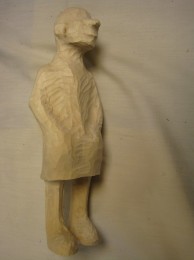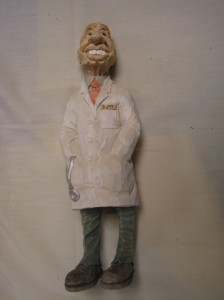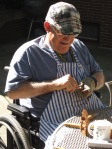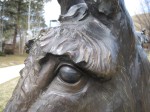148. Hand carved, Old Tar. Don’t rock the boat.
Maybe too many Popeye cartoons. Maybe a tough day at the office. Whatever the reason, this Old Tar isn’t too happy, even if he knows the ropes. Does he look like he’s all at sea or a loose cannon.
Perhaps he is upset for being ordered to “shake a leg.” This nautical term came to mean either “hurry up” or “to dance.” Does he look like a guy who would want to dance? Not all “old tars”, or sailors liked dancing. One reason for the nickname, by the way, might have been because sailors were said to use grease or tar in their hair.
This sailor is in a private collection in Michigan. Shalom.
“A good name is better than fine perfume…” Eccl 7:1a

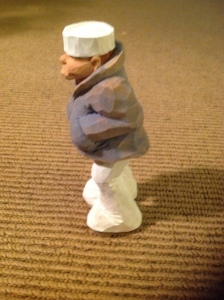

#43 Wood Carving: This is a test
MERRY CHRISTMAS TO ALL. AND A HAPPY NEW YEAR.
Technical difficulties yesterday. Suddenly my posts stopped showing up on Facebook. I am trying to figure out why this is so. While I am trying to figure that out – this post is really a test to see if I have marked the correct app in FB – enjoy a few more carving pictures.
“Suddenly a great company of the heavenly host appeared with the angel, praising God and saying,
‘Glory to God in the highest heaven,
and on earth peace to those on whom his favor rests.’
When the angels had left them and gone into heaven, the shepherds said to one another, ‘Let’s go to Bethlehem and see this thing that has happened, which the Lord has told us about.'” Luke 2:13-15
#24 Wood carving: Bones, MD. A Bishop roughout
Wood carving is one of my hobbies. Did you notice the word “one.” That means, beside teaching,
leading in my church, living in a family – wife and three adult children, and a host of other things I have chosen to do, I have several hobbies. Carving happens to be near or at the top of the list of hobbies. So what does that mean?
It means that not all the carvings I begin will be completed any time soon. It also means that some commissions I have taken are standing in my basement at various stages of completion. I think you will understand in the
next few posts I make.
The one commission which has been on my mind a lot lately, and on the minds of several others, is “Bones, MD.” This is a Phil Bishop rough out which I promised to a friend many months ago. Dare I say that I have the check in my wallet just waiting to be banked. (At least I have not lived with the money in my account for these past four months, then I would be even harder on my self.) I have tried to use the pressure of the un-cashed check to drive me to finish the carving.
While the bad news is that the carving awaits completion, the good news is that with ten more minutes of
carving (and for those of you who do not know the carving world, for a fussy carver that is an easy half hour) the piece will be ready for painting.
I have included in this post pictures of rough outs a various stages of completion. The first are of a rough out that has some of the surface
skinned. Skinning is taking off the duplication machine fuzzy fibers. Any of those fibers are left on the carving will immediately be seen in the final step of painting. They will take the paint so differently that all who look at the carving, from non-carvers to expert carvers, will notice.
The second piece, nearly completed carving, which will receive paint in the next two weeks, is the piece promised. You will notice that it needs hair lines. Also, it needs buttons and a few more wrinkles and creases. These will add shadows and highlights to the piece
which the untrained eye will miss without knowing what is wrong with the piece if they are not added.
The final carving is a study done under Phil Bishop’s direction. It also is incomplete – did you notice? The paint job is nearly finished. There are a few highlights to add and the last stage of the eye needs to be put in. Then the piece will be dipped in linseed oil sealing the carving. Hope I will have a few finished pieces to show you soon.
“It is good to praise the Lord and make music to your name, O Most High, to proclaim your love in the morning and your faithfulness at night.” Psalm 92:1,2
# 18 A cool place for inspiration: Leanin’ Tree
Wood carvers are always looking for ideas. They are also looking for help in how to carve something in an interesting way.
Where to go? We will have many more entires on sources for ideas. We plan to discuss books, pictures, photos, calendars, other artist’s work. One of my sources of inspiration is Leanin’ Tree .
I have enjoyed Leanin’ Tree. Leanin’ Tree is part of Trumble Greetings, a greeting card company.
What interests me for this blog, and there are many aspects of Leanin’ Tree which do interest me – not least the cards and
books I have purchased from them, is the Western art which Mr. Ed Trumble has gathered. This collection is now on display in Leanin’ Tree’s museum at the main office in Boulder, Colorado.
As you can tell from the pictures included in this entry, what is of interest here is not necessarily the entire piece of art. The close up shots of carvings allows me to see how a particular artist dealt with a
particular challenge in representing real life in an artistic way. The animals here are not real, they are art. What liberties did the artist take with reality? How did he or she capture the “wolf-ness” or “eagle-ness” in bronze or stone? Was there exaggeration in the eye details or in the length of the face? What kinds of cuts would I have to make in order catch the same movement in wood? Could I use a similar movement in a piece to give my work flow or interest for the viewer?
A visit to Leanin’ Tree in Boulder would be a worthwhile stop. If that is not possible, an online bookmark for the museum or a purchase of one of the museum’s books would be a valuable addition to any carver’s collection. They would provide hours of enjoyment and inspiration.
# 16 Carving “found wood”
One of the joys of wood carving is working with found wood. I will say much more on the subject in a later post but I wanted to introduce the topic here. “Found wood” is material for carving which you the carver go out and find. The carving presented here is such a piece. This snowman was carved from a white pine branch which was picked up after a severe Michigan wind storm. The branch was cut to four foot length and
stored in my garage for several years. After curing/drying it
became useful for carving.
A part of the pleasure in carving found wood is the satisfaction which comes from making something beautiful out of a piece of wood many would
burn or just throw into the trash heap. This snowman, with its remaining bark, reminds the viewer of its origin in the forest. And that reminder makes using “found wood” all the more enjoyable.
See the Gift Shop for pricing.
Psalm 95:1
Come, let us sing for joy to the LORD; let us shout aloud to the Rock of our salvation.





